Wilco Liebregts** and Keith Chapman***
* Parts of this paper were presented during the XLI coco technical meeting and coconut festival, 5 to 9 July 2004, Santo, Vanuatu, Asia and Pacific Coconut Community, Jakarta, and subsequently published in the report of the meeting.
** Biological Control Specialist, Eco-Consult Pacific, P.O. Box 5406, Raiwaqa PO, Suva, Fiji Islands; e-mail: [email protected]
*** Plant Production Officer (Industrial Crops), FAO Regional Office for Asia and the Pacific, Maliwan Mansion, 39 Phra Atit Road, Bangkok 10200, Thailand; e-mail: [email protected]

Figure 1: Brontispa damaged coconut palm in southern Viet Nam
Abstract
The coconut hispine beetle, Brontispa longissima Gestro (Coleoptera: Chrysomelidae) is one of the most damaging pests of coconut and a range of ornamental palm species. Both larvae and adults of the beetle feed on tissues of developing, unopened leaves of the trees. The beetle can cause significant production losses, and high infestation levels may result in tree death. With assistance from FAO, the natural enemy Asecodes hispinarum, a larval parasitoid, has been collected in Samoa and introduced into affected countries in Southeast Asia and the Pacific to act as a biological control agent. The parasitoid has become established in Maldives and Viet Nam, and initial results indicate that pest populations and damage levels are declining.
Introduction
The coconut hispine beetle, Brontispa longissima Gestro (Coleoptera: Chrysomelidae) is one of the potentially most serious pests of coconut palms. Both larvae and adults of the beetle inhabit the developing, unopened leaves of the coconut palm where they feed on leaf tissues. Where an attack is severe, complete defoliation of the palms may result. Prolonged attack, particularly to palms that are young or suffering from poor growing conditions, may result in death of the tree. With other palms productivity is severely affected by sub-lethal attacks.

Figure 2: Brontispa adults on young coconut leaf
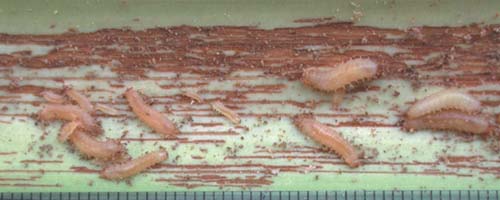
Figure 3: Brontispa larvae and feeding damage on coconut leaf
Brontispa longissima is believed to be endemic to Indonesia and possibly also to Malaysia, Papua New Guinea and the Solomon Islands. In the twentieth century the beetle was accidentally introduced in several other countries in Southeast Asia and the Pacific, and as a result has now become widespread there. The pest however was not recorded from continental Southeast Asian countries until the late 1990s when it was first detected in the Mekong Delta in Viet Nam.
Specialists suspect that this species was introduced into southern Viet Nam in shipments of ornamental palms. The pest spread rapidly northward and westward, causing significant losses to the coconut industry. The introduction of the beetle in Hainan Island in southern China, is believed to have occurred in a similar way with a shipment of ornamentals from the mainland or from Taiwan province. At around the same time, the pest was introduced into the Maldives. The pest was first noticed in Thailand in February 2004, and a few months later in Lao PDR and Myanmar. Singapore has also reported damage by the pest, but it is unclear if this is a new incursion. Although the pest has not yet been recorded from Cambodia, it is highly likely that the pest has reached these countries as well.
Importance of the coconut industry in recently affected countries
There are about 173 000 hectares of coconut grown in Viet Nam, that directly support about 70 000 families. Coconut is an important source of income for many households. Depending on the product, additional household incomes from the production of high-value products ranges from US$1-2.33 per person per day, US$34.50-62.10 per person per month, or US$42.20-55.25 per household per month. This income, in addition to the income from the coconut endosperm (kernel), can lift the coconut growing family above the poverty line. Since coconut oil is used domestically as cooking oil and as a raw material for oleochemicals, and the fiber and shell products are exported, coconut reduces vegetable oil imports and generates foreign exchange. Thus, loss of coconut palms may have serious macroeconomic and environmental impacts, as well as a microeconomic impact at the level of smallholder households as all family members get involved in producing the many coconut derived products.
Thailand's coconut industry consists almost exclusively of smallholders with just over 50 000 farmers involved; most of these farmers have an area of about 2.5 ha of palms. Yields are low at around 6.6 MT per hectare and incomes are low as the price per kg is only about TB 8. The total area under coconut is estimated at 328 000 hectares which produces about 1 146 million nuts or about 344 000 MT in copra equivalent, representing a total value of TB 902.16 million domestically and with exports of TB 512 330 million (TB 41 = US$ 1). The crop not only provides an important contribution to the economy and livelihoods of thousands of small holders, but provides a very significant land cover for poor coastal soil areas, and is a major feature of the country's tourist industry.
In Hainan province, China, the pest seriously affects coconut farmers, but also the rapidly developing tourism industry. In support of that industry, the island province has commenced a beautification campaign which includes the planting of coconuts and many ornamental species in cities and along major roads. Most of these palms have been affected by the beetle. In an attempt to control the pest and prevent it from spreading, host plants have been removed from a zone of 2 km around infested areas. In these areas, broad spectrum insecticides are applied to the crown, and sometimes injected in the trunk, but this appears to have had little effect in preventing further spread of the pest.
In the Maldives and Nauru, the coconut is perhaps the single most important plant and crop, as on these resource-poor atolls it is truly the 'tree of life', as it provides food, timber, and housing materials to the islanders. In the former, the tree is the most significant to the all-important tourist industry, which accounts for a large proportion of GDP.
Taxonomy
Species belonging to the genus Brontispa are mainly found in Southeast Asia and the western and northern Pacific. A number of species have been described, although several revisions of the genus have seen a considerable reduction in the number of species. The latest major revision of the subfamily Hispinae, to which the genus Brontispa belongs, was in 1957 and no further studies on the taxonomy of the genus Brontispa have been implemented since. The sudden and rapid spread of the pest into Southeast Asia, and the fact that there is considerable intra specific variation in colour patterns within the species B. longissima, has caused confusion among plant protection specialists in the region, and now urgently warrants a revision of the genus Brontispa.
Impact of the pest in Southeast Asia and the Pacific
In 2001, a few years after its incursion into southern Viet Nam, surveys estimated that Brontispa affected some one million coconut palms in 150 000 ha of coconut in all 21 southern provinces. The beetle since advanced rapidly into the central provinces and in August 2002 was distributed over 30 provinces, where it infested an estimated six million coconut palms over a much larger area. Survey reports suggest that damage can be serious but that it varies among provinces, with the most severe damage recorded in Ben Tre province. It is now considered that some ten million trees are affected, and that the pest has reached the northern provinces, including the capital Hanoi.
In the Maldives, an archipelago of some 1 000 islands south of India, the pest was first noticed in December 1999 on Sun Island resort on the island of Nalaguraidhoo in south Ari Atoll. It is likely that the introduction of the pest occurred with the importation in 1999 of ornamental palm trees from nurseries in Indonesia and Malaysia when developing the resort. The pest has since spread to nine nearby islands in the atoll, and was recently (April 2004) discovered at Hulhule Island, near Male. An eradication campaign is underway, and there are indications that it may be successful.
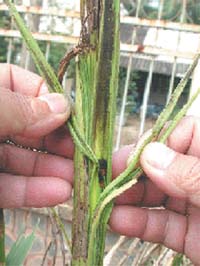
Figure 4: Brontispa damage on young
leaves
(Photo credit: Tran Tan Viet)
In Thailand the beetle was first reported from the southern provinces Prachuap Khiri Kan, Surat Thani in February 2004. Surveys showed that the pest was present in the southern provinces of Chumphon, Songkhla, Narathiwat and Pattani, as well as Bangkok. It is probable that the pest originated from Malaysia, and not from Viet Nam. The pest incursion shows considerable similarities with the one that occurred in Viet Nam, indicating that it will spread over the mainland and eventually to nearby islands.
In the Pacific, no further incursions of Brontispa occurred in the years following its establishment in (Western) Samoa in the early 1980s, until the beetle was detected in Nauru in April 2001. A brief survey suggested that the main infested areas were around the Buada lagoon, Ijuw, Anabar, Anabare and Yaren districts, where a considerable number of coconut palms showed heavy damage by the beetle.
The significant risk of the pest spreading to nearby countries such as India, Sri Lanka, Myanmar, Bangladesh is of major concern. These countries are at considerable risk, since the beetle will not be stopped at land borders: only natural barriers such as oceans and mountain ranges may halt the natural dispersal. For these countries, which have significant coconut industries, the pest incursion would be catastrophic. Quick action will see not only the reduction of damage levels, but also a slower rate of dispersal of the pest. Moreover, the natural enemies, once established, will follow any further outward migration of the beetle, thus reducing the need for continuing releases in areas newly infested by the pest.
Control measures
With no viable alternative methods available, Viet Nam embarked on a massive campaign whereby the use of chemical pesticides was subsidized in an attempt to control the beetle outbreak and reduce its rate of spread. This campaign, and those implemented by provincial governments in the Mekong Delta already cost some US$300 000 by the end of 2002. In addition, it is estimated that farmers have spent a similar amount in pest control measures. That year, subsidy levels reached an estimated US$0.33 per coconut tree. With the invasion of the central provinces, the impact becomes even more serious as coconut palms are not cultivated intensively there, and farmers are much poorer than their southern colleagues, and are not able to pay for any chemical protection of their trees.
In the Maldives, management of Sun Island resort in June 2000 commenced a control programme that involved application of insecticides to the crown as well as stem injection of infested trees. In addition, seedlings were removed and destroyed on all islands. Estimates of direct economic losses between June 2000 and February 2003 amount to US$237 350 - for labour and insecticide application costs. In addition, losses in revenue from coconut sales, and coconut purchases for 'welcome' drinks for resort guests were estimated at US$32 800. The control programme, however, could not prevent the spread of the pest to nine neighbouring islands, and there continues to be a serious risk of further spread of the pest to other islands in Ari Atoll, and to other atolls in the country.
The use of pesticides in coconuts raises serious concerns about the health risks of the farmers, families and consumers. Coconuts generally sell for a low price, and pesticide application to trees for coconut beetle control is particularly hazardous. The trees are tall; applicators must climb up to the crown, and workers ask a high price for this dangerous task. They typically work without protective clothing, and are exposed to pesticide through the skin and via inhalation as they struggle to keep their balance while spraying beetle larvae in folded young leaves. Moreover, coconut plantations are often situated near homes, so that detrimental effects on the health and environment of households, fish ponds gardens and domestic animals due to pesticide exposure must be seriously considered.
Biological control
Complete control of B. longissima with high cost/benefit ratios has been achieved in several countries by importing and establishing parasitoids that attack immature stages of the pest. These successful locations include various Pacific and East and Southeast Asian countries. Known egg parasitoids include Haeckeliana brontispa Ferriere and Trichogrammatoidea nana Zehntner (Hymenoptera: Trichogrammatidae), and Ooencyrtus sp. (Hymenoptera: Encyrtidae). Several parasitoids in the wasp family Eulophidae attack the larval and/or pupal stages of Brontispa, including the larval parasitoid Asecodes sp. and the pupal parasitoid Tetrastichus brontispa Ferriere. A strain of the entomopathogenic green muscardine fungus Metarhizium anisopliae was isolated from B. longissima in China and formulated as a bioinsecticide. The fungus was also used in the 1980s in Samoa to control the pest on young coconut seedlings in the field and in nurseries, but its application to larger, established trees was problematic and unfeasible.
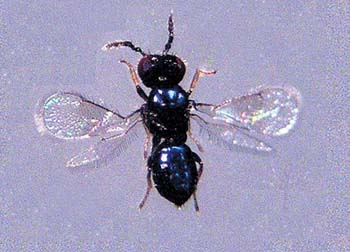
Figure 5: The parasitoid Asecodes
hispinarum
(Photo credit: Tran Tan Viet)
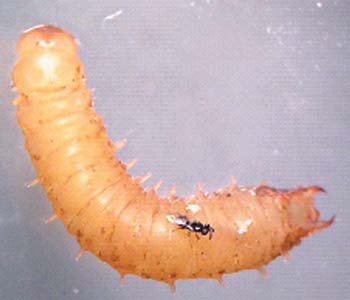
Figure 6: Asecodes parasitising Brontispa
larva
(Photo credit: Tran Tan Viet)
FAO assistance
On request of the individual countries, the Food and Agriculture Organization of the United Nations (FAO) provided assistance to help developing control strategies of the pest in the affected countries. Bilateral Technical Cooperation Projects (TCP) to a value of more than US$650 000 are currently underway in Viet Nam (2003-2005), Maldives (2003-2005) and Nauru (2003-2004). Similar project proposals have been prepared for Thailand and PR China; a fast-track TCP was approved for the former in October 2004. Furthermore, technical assistance has been provided to Sri Lanka to increase awareness of this important pest. All projects seek to establish sustainable control of Brontispa through the development of an IPM programme based on classical biological control. For most countries, a public awareness campaign on the pest and the risk of it spreading further is also part of the project.
The larval parasitoid Asecodes hispinarum was collected in Samoa in 2003 and introduced, reared and released in Viet Nam, the Maldives and Nauru to combat the beetle. Although the parasitoid is established in the two former countries with promising prospects for achieving control of the beetle there, it is yet too early to determine its success in reducing beetle populations to sub-economic damage levels, as pest-parasitoid interactions and population dynamics fluctuate considerably in the first few years following introduction of the natural enemy. The effectiveness of the parasitoid is likely to be affected by environmental conditions, particularly in the various climate zones, and its impact on the pest may vary accordingly. In view of this, FAO recognizes the need for additional natural enemies to strengthen the biological control programme, and is seeking support for the implementation of exploratory surveys in Indonesia, Papua New Guinea and the Solomon Islands. The project also includes a taxonomic revision of the genus Brontispa.
Preliminary results
Results from Viet Nam confirm the establishment of the parasitoid in those provinces where it was released, and observations at and near release sites indicate that beetle damage has reduced considerably. It is expected that damage levels will be reduced to levels similar to those seen in Samoa, where Brontispa damaged palms are quite uncommon. Surveys have shown that the dispersal rate of the parasitoid from the release sites is some 5-8 km per two months.
In the Maldives and Nauru, field establishment of the parasitoid was confirmed after two and five months after initial field releases in February and November, respectively, but further recovery of the beneficials in Nauru has so far been irregular. In both countries, no significant reduction of damage has yet been observed that could be attributed to the impact of the parasitoid, although the newly emerging leaves appear to show less damage.
In Viet Nam, a recent study on the costs and benefits of the biological control programme has tentatively concluded, that by mid 2002, 9.4 million trees were infected by Brontispa. Up to mid 2004, the pest infestation has caused 30 percent fruit production loss, the death of 5 percent of trees (at an estimated cost of US$23.8 million), and has damaged 13 000 ornamental palms (at an estimated cost of US$838 000). The cost for pesticides applications amounted to approximately US$715 000, which was borne by the federal and provincial governments. This does not take into account the expenses and labour costs borne by the farmers and volunteers involved in the control programme. Overall, the cost of the FAO TCP Project (US$350 000) is very small in comparison with the losses caused by the pest. Using a unit price of US$0.10 per coconut (including husk), a tentative analysis of economical data points at a return of one billion dollars over a 30-year period, or a return US$2 000-3 000 for every dollar invested in the project. With prices currently near the US$0.50 mark, these returns have increased five-fold. Taking into account that much of the groundwork for the collection, identification, rearing and importation of A. hispinarum was done under the FAO-Viet Nam TCP, the cost-benefits are many times higher when taking into account the coconut industries for other Southeast Asian countries.
Peter Ooi*
* Chief Technical Adviser, Integrated Pest Management for Cotton in Asia, FAO Regional Office for Asia and the Pacific, Maliwan Mansion, 39 Phra Atit Road, Bangkok 10200, Thailand; e-mail: [email protected]
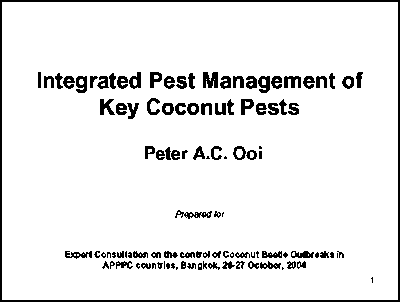
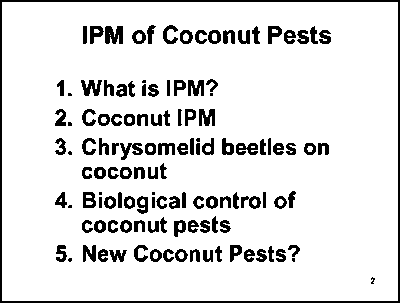
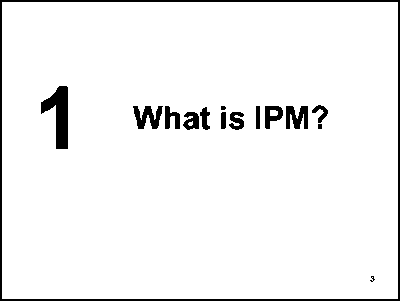

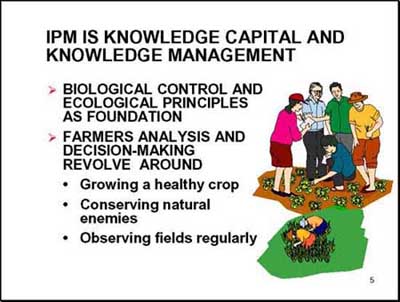

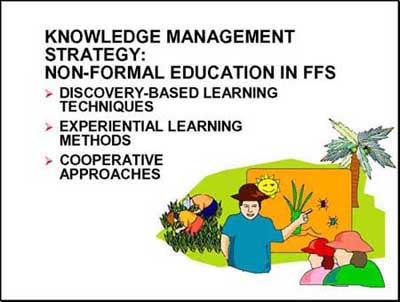
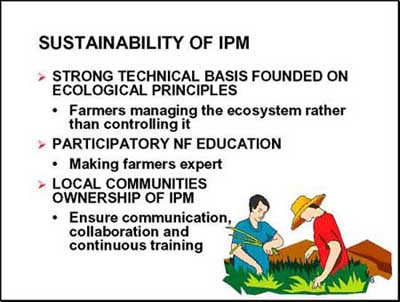



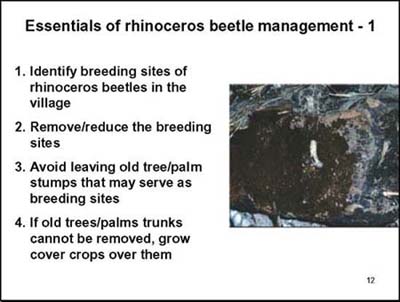
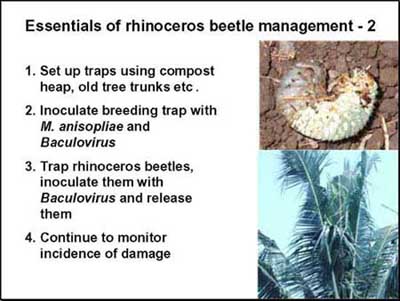
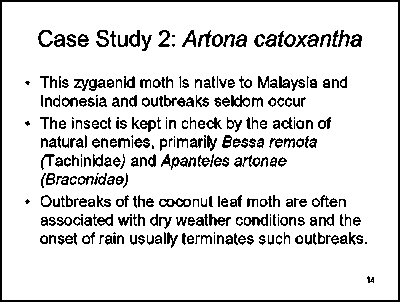
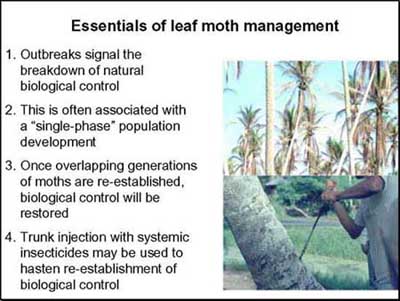
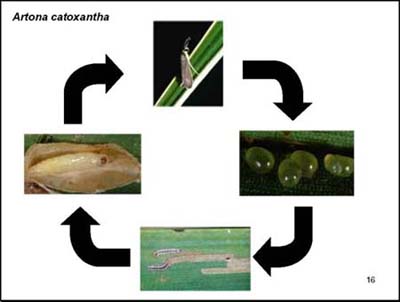


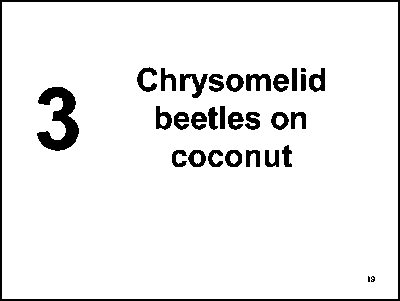


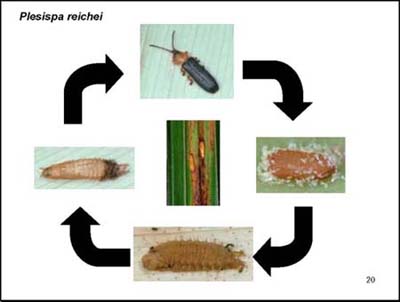
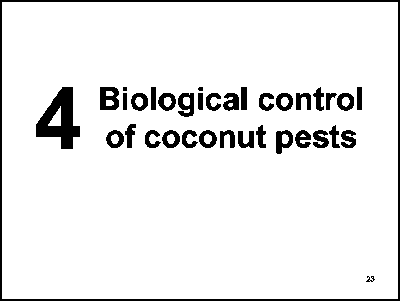
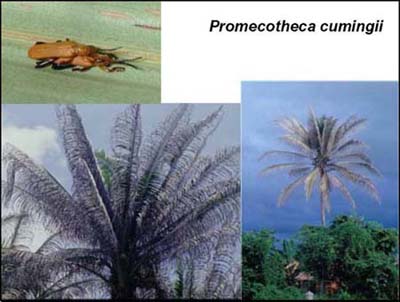

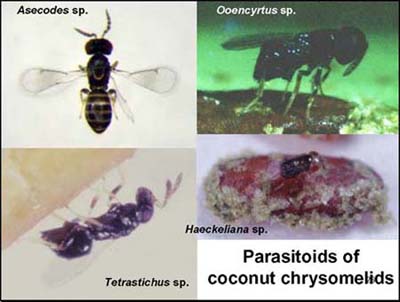
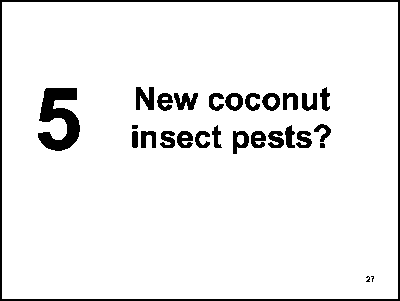
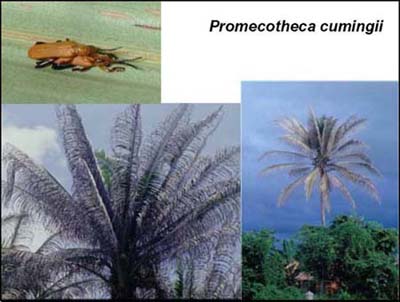

Hean Vanhan*
* Chief, Plant Protection and Phytosanitary Office (PPPSO), Ministry of Agriculture, Forestry and Fisheries (MAFF), Phnom Penh, Cambodia; e-mail: [email protected]
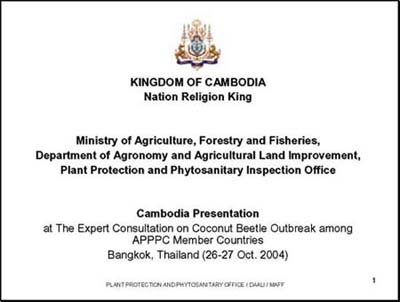
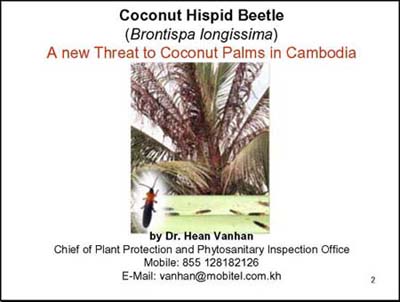

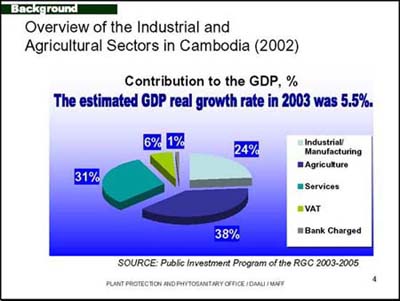
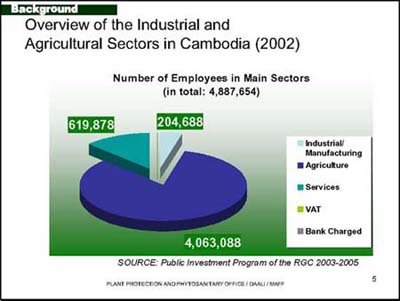
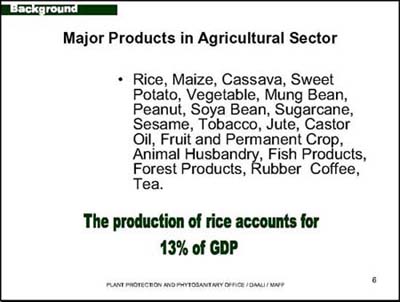

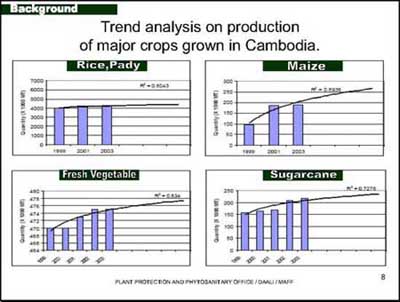
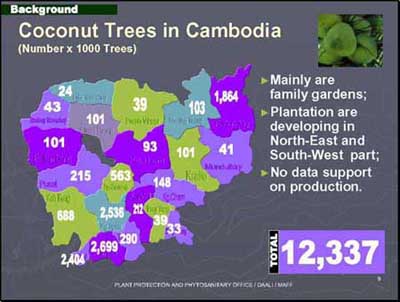
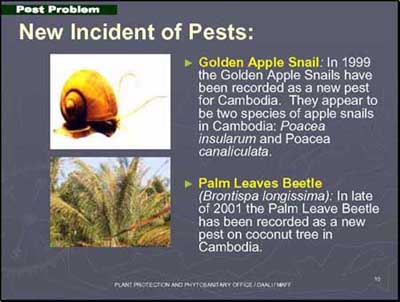


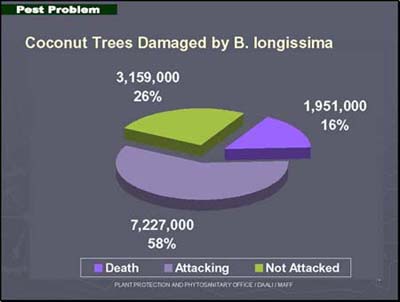
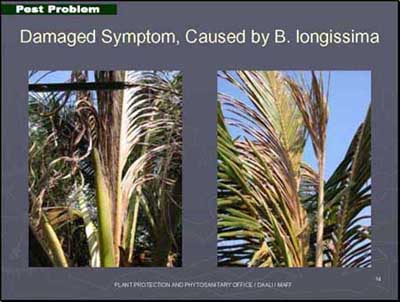
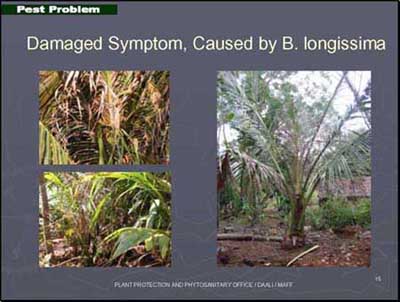
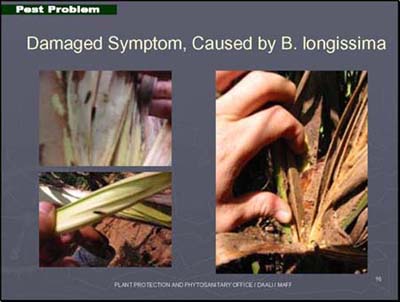
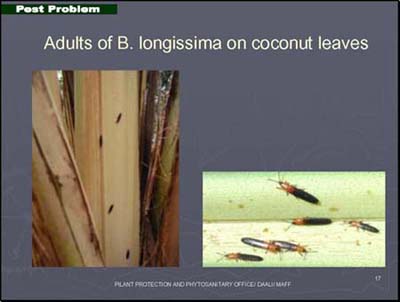
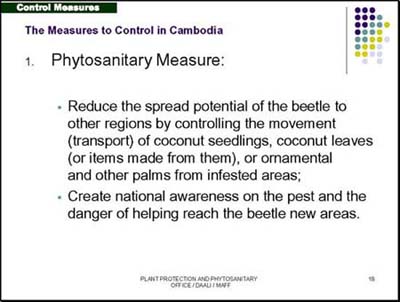
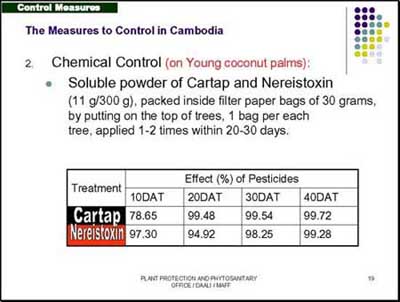
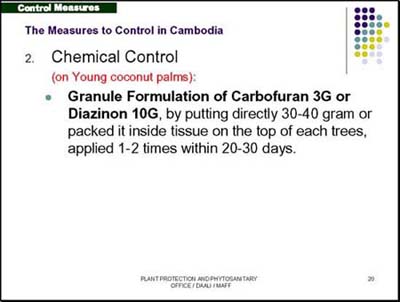
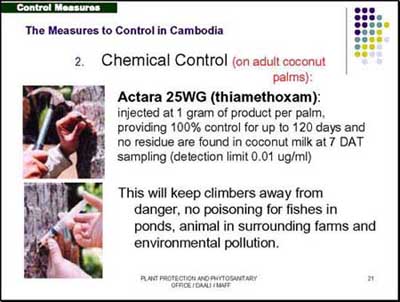
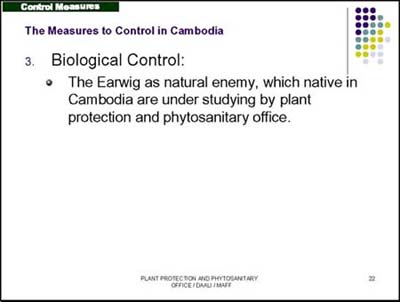
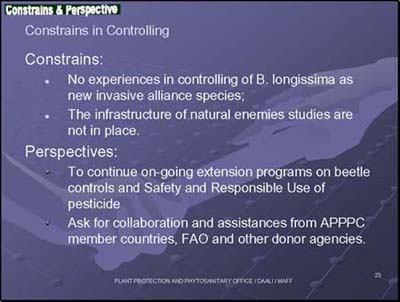
Fu Yueguan* and Xiong Yankun**
* Environment and Plant Protection Research Institute, Chinese Academy of Tropical Agricultural Sciences, Dangzhou City, Hainan province; e-mail: [email protected]
** Agronomist, National Agro-Technical Extension and Service Centre, 730 Building 20, Maizidian Street, Chaoyang district, Beijing; e-mail: [email protected]
Coconut leaf beetle (Brontispa longissima) is classified as a species within the second class plant pest of forbidden entry to China. The beetle has been found in some places in Hainan, Guangdong and Taiwan provinces, especially in Hainan province. All levels of Chinese Government attached great importance to the epidemic. Many measures have been taken to prevent the beetle spreading, control the beetle and decrease its economic impacts. Details as the following:
1. Information about the beetle outbreak
1.1 Distribution
In China the coconut leaf beetle was first time found in Haikou city in Hainan province in June, 2002. The subsequent surveys of the beetle were conducted by Hainan province government for three times. The results of surveys indicated that the beetle occurred in 16 counties, infested about 817 thousand individual plants, endangered areas reached 40 thousand hectares or so, the beetle caused serious damage in Haikou and Sanya cities. Medium level attacks happened in Wenchang, Qionghai, Wanning and Tunchang, whereas light attacks took place in other occurring areas in Hainan province. In addition, the beetle was also found in few places in the Guangdong province.
1.2 Damage
The beetle attacks palms of all ages, especially damages young palm trees in nurseries and new leaves of palm trees, confining its damage to the tender unopened central leaves of palm trees. Neglected palms are more heavily attacked. The beetle sometimes occurred together with other palm pests. In some cases fruit shedding took place with loss of yield. In most cases all the central leaves were brown, newly-formed leaves were very small; the trees appeared ragged and may ultimately die. In Hainan province, 11 species of host palm trees such as Cocos nucifera, Areca catechu, Archontophoenix alexandrae, Roystonea regia, Washingtonia fllifera, Hyophorbe lagenicaulis, Washingtonia robusta, Liviston chinensis, and Chrysalidocarpus lutescens are found. The major host plant is Cocos nucifer.
1.3 Biology and ecology
The beetle laid eggs in groups between or inside the tightly folded leaflets covering each egg with excreta. The eggs hatch after an incubation period of about five days. The newly hatched larva begins to feed between and inside unopened leaflets. The number of instars varies from five to six. The larvae are fairly sedentary and avoid light. The larval period is 30-40 days, followed by a pre-pupal period of three days and a pupal period of six days. The development from egg to adult takes five to seven weeks. The adult beetles, which also seem to avoid light, are nocturnal. Adults feed among the young unopened leaflets. There is a pre-oviposition period of one to two months and 100 or more eggs may be laid. Dry periods favour the development of Brontispa populations. The beetle is only capable of weak flight, the main way of long-distance spread is migration aided by human activities.
2. Epidemic management
A leading group and experts group of controlling coconut leaf beetle were established to control and prevent the spread of beetle epidemic after its report in Hainan province. The leading group, directly managed by Deputy Chief General of Hainan province government, was responsible for organizing, commanding and inspecting all kinds of activities of controlling the beetle. Experts group, with responsibility for putting forward technical measures and policy advices on controlling beetle epidemic, consisted of plant protection experts and plant quarantine experts. Hainan province prepared and issued 'working programme on controlling coconut pests', with relevant arrangements for controlling coconut pest. Up to now, 85 percent infested plants have been restored. China undertook the following control measures.
2.1 Quarantine measures
Preventive measures, such as blockading and cutting off coconut trees, were taken to prevent the beetle from spreading out. In case of widespread epidemic occurrence, isolated areas were established, three kilometers from epidemic central spot to the outer; insecticide bags were hung on the palm trees in isolated areas. Transport of palm trees from other provinces to Hainan province, or from epidemic areas to other places was forbidden. Check points were established to enforce this regulation. Regulatory brochure 'method of inspecting coconut leaf beetle' was developed and issued.
Epidemic survey was started immediately and epidemic survey spots were established at which highly susceptible hosts were planted. Regular surveys were carried out. A mechanism of reporting epidemic was established for timely action; the telephone number of epidemic reporting service was publicized. A 'manual of controlling coconut leaf beetle' was developed and distributed to the public so that once anybody found the infesting beetles at any spot they could report it.
2.2 Chemical control
Initially chemicals were used to control the beetle after the report of epidemic in 2002. There are two periods of chemical control in China. Traditional chemical control measure was taken against the beetle in the first period, between June 2002 and December 2003. Broad spectrum insecticides such as imidacloprid, cypermethrin, deltamethrin and matridine were applied by spraying with high pressure applicator or elevator at intervals of three to four weeks. Some insecticides were injected to the trunk of infested palm trees. All of these treatments showed a certain degree of effectiveness in the period.
The second period was from December 2003 to July 2004 when a new pesticide powder, developed by South China Agriculture University, was mainly used. The insecticide powder was put into bags that were hung on the palm trees. Treatment with this pesticide powder could not only effectively control the beetle with long effective duration and little damage to environment, but also effectively prevent the beetle from spreading. Satisfactory control could be achieved if insecticide bags were used in beauty spot, on sides of street and isolated areas. Up to now, 1.4 million insecticide bags have been applied and about 0.8 million palm trees saved; infested palm trees are beginning to recover from serious damage.
2.3 Biological control
Biological control is of primary importance for the sustainable control of the coconut leaf beetle, which is advocated by China. Two biological agents, Asecodes hispinarum and Metarhizium anisopliae were tested against the pest, and promising results have been obtained. Now these have been used in the field on a small scale.
Asecodes hispinarum
China organized expert group visit to study the biological control of coconut beetle with Asecodes hispinarum in Viet Nam in December, 2003. With the help of biocontrol specialist of FAO and Viet Nam experts and officials, Asecodes hispinarum was brought to Hainan in March 2004. Environment and Plant Protection Research Institute, Chinese Academy of Tropical Agricultural Sciences, headquartered in Hainan was responsible for study under isolated conditions. A series of related research has been conducted and much progress has been made. Results of studies showed that the imported A. hispinarum consignment did not bring dangerous microbes and parasites, and the agents did not parasitize other main native insects, such as lady bird beetle, silkworm, honeybee, moth. Now larvae of the coconut leaf beetle can be fed on preys or artificial or semi-artificial diets. Asecodes hispinarum has been released in the north (Haikou), the south (Sanya) and the east (Qionghai) of the island since August 2004, after safety evaluation of Asecodes hispinarum completed. A primary survey for the effects of the natural enemy release found that the number of coconut leaf beetle decreased greatly and infested trees recovered to a certain degree. Parasitization rate of 10-40 percent was recorded two months after the release. A special apparatus for the release of Asecodes hispinarum was invented. The habit and life history of Asecodes hispinarum has been surveyed. The effects of instar of the beetle larvae on parasitism and development of Asecodes hispinarum, the influences of temperature, humidity and photoperiod on the development of Asecodes hispinarum, have be investigated.
Metarhizium anisopliae
In total 11 strains of Metarhizium anisopliae were screened out from many fungal strains, of which ten strains were used for field trial in Haikou. Field trial revealed that two strains infected the beetle quickly with high mortality compared with others. Coconut trees turned green, a lot of beetles died in the field after these two strains formulations were sprayed. However, microbial control faced two problems. One is that new strains or formulations need to be screened out to suit the climatic conditions in South China, especially in Hainan province. The other is to develop spraying equipment that can deliver insecticide to high palm trees with low cost.
2.4 Study
A series of studies were carried out in China on B. longissima, including biological characteristics, biological control, and attractants.
Biological characteristics
The results of study indicated that the developmental threshold temperature and effective cumulative temperature of coconut leaf beetle were 11.08°C and 966.2°C respectively. Temperature between 24°C and 28°C was the favourable range for the growth of the beetle. Royal palms (Roystonea regia) and coconut were its primary hosts, while Livistona chinensis and oil palm were its secondary hosts. Field survey showed presence of ants and parasitic acarid, but no other parasitic natural enemies in Hainan. Beetles killed by Metarhizium anisopliae were also found in the field.
Biological control
The techniques for the mass rearing of the coconut leaf beetle and its parasitoid Asecodes hispinarum have been mastered by our research institutes. Factories for raising the beetle and Asecodes hispinarum were established, which could produce 2 000 coconut leaf beetles and 50 000 Asecodes hispinarums per day. Tetrastichus brontispa has been introduced from Taiwan province, and the study to use it as biological control agent is in progress.
Attractants
Some attractants have been found and one formulation is in the stage of field trial.